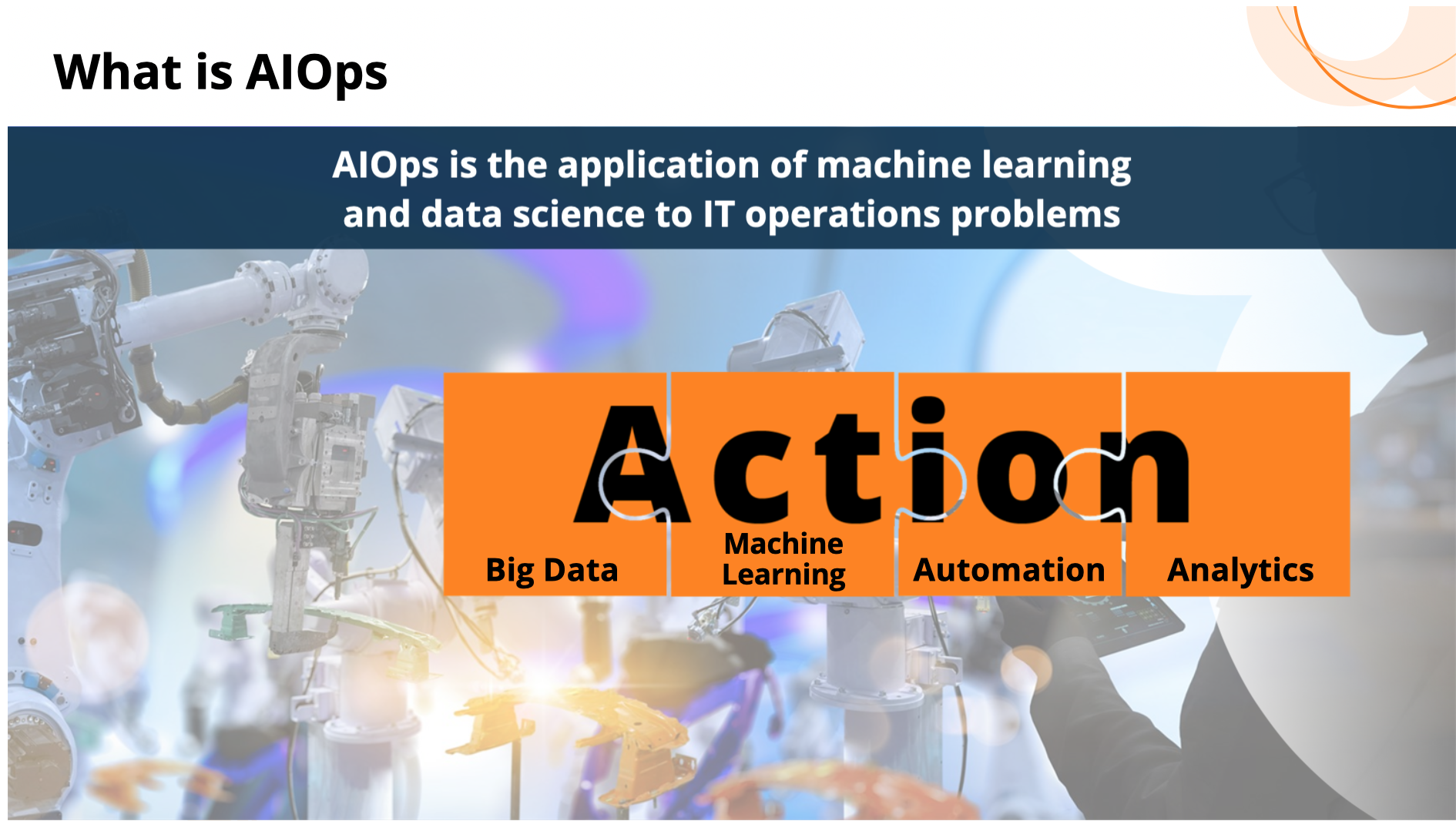What is AIOps

AIOps
AIOps employs artificial intelligence to streamline the administration of IT operations while accelerating and automating the resolution of issues in intricate modern IT settings.
What is AIOps?
Artificial intelligence (AI) is used in AIOps, which stands for artificial intelligence for IT operations, to improve IT operations. In particular, AIOps makes use of big data, analytics, and machine learning to do the following tasks:
- Assemble the enormous and expanding volumes of operational data produced by numerous IT infrastructure components, apps, and performance-tracking ,technologies.
- Intelligently separate the "signals" from the "noise" to find important occurrences and trends associated with system performance and availability problems.
- Identify the underlying reasons and submit them to IT for quick action and correction; in certain circumstances, these problems can be resolved automatically without human interaction.
AIOps can help IT operations teams respond more quickly and proactively to slowdowns and outages, with less effort, by replacing manual IT operations tools with a single, automated platform, monitoring tools.
This can help meet customer expectations for uninterrupted application performance.
It ties together customer expectations for little to no disruption in application performance and availability on the one hand and a more diversified, dynamic, and challenging-to-monitor IT world. AIOps platforms is viewed as the future of IT operations management by the majority of specialists.
Why do we need AIOps?
Most businesses are now moving away from the static, separate physical systems that made up their traditional infrastructure and toward a dynamic mix of on-premises, managed cloud, private cloud, and public cloud environments, powered by resources that are virtualized or software-defined and scale and reconfigure on demand.
These settings' applications and systems together produce a never-ending flood of data. The average company IT infrastructure produces two to three times more IT operations data annually, according to Gartner estimates.
The volume is too much for conventional domain-based IT management solutions to handle. They are unable to effectively separate the important events from the deluge of surrounding info. Data across various yet interconnected environments cannot be correlated. Additionally, they are unable to offer timely insight and predictive analyses. In order to meet user and customer service standards, IT operations teams must respond to problems quickly.
The answer is AIOps, which offers visibility into performance data and dependencies across all environments, analyzes the data to extract critical events related to sluggishness or outages, and automatically notifies IT employees of issues, their causes, and suggested fixes.
How does AIOps work (AIOps Tools )?
Reviewing the functions that each AIOps component technology—big data, machine learning, and automation—plays in the procedure is the simplest technique to comprehend how AIOps operates.
- To consolidate disparate IT operations data in one location, AIOps leverages a big data platform. These details may consist of the following:
- Performance and event statistics from the past
- real-time operations events streaming
- System metrics and logs
- Data from networks, such as packet data
- statistics on incidents and ticketing
- data based on related documents
Then, AIOps employs specialized machine learning and analytics capabilities:
- Analytics tools like rule application and pattern matching are used by AIOps to sift through your IT operations data and differentiate signals—significant abnormal event alerts—from noise (everything else).
- Determine the underlying reasons and offer remedies: AIOps may correlate anomalous events with other event data across environments using industry- or environment-specific algorithms to identify the root cause of an outage or performance issue and offer fixes.
- Automated reactions, such as prompt proactive action: AIOps can at the very least automatically route notifications and suggested fixes to the appropriate IT teams, or even set up reaction teams based on the nature of the issue and the fix. It can frequently process machine results.
Benefits of AIOps
The main advantage of AIOps is that it makes it possible for IT operations to locate, address, and fix slowdowns and outages more quickly than they can by manually sorting through alerts from various IT operations tools. This has the following special advantages:
- AIOps may detect root causes and suggest solutions faster and more precisely than humans can by sifting through IT operations noise and correlating operations data from various IT environments. This leads to faster mean time to resolution (MTTR). This enables firms to set and attain MTTR goals that were previously unimaginable. For instance, Nextel Brazil, a telecom company, used AIOps to cut down incident response times from 30 minutes to under 5 minutes.
- Adapt your management style from reactive to proactive to predictive: AIOps continuously improves at recognizing less urgent warnings or signals that correspond with more urgent circumstances because it never stops learning. It can therefore offer proactive notifications that enable IT teams to resolve possible issues before they result in sluggishness or disruptions.
- Your IT operations and your IT operations personnel should be modernized. AIOps operations teams only receive alerts when certain service level thresholds or parameters are hit. These alerts come complete with all the context needed to make the best possible diagnoses and conduct the best and quickest corrective action. Your IT operations team may concentrate more on tasks with more strategic value to the business as AIOps learns and automates, helping to "keep the lights on" with less human effort.
AIOps use cases
Other significant business and IT objectives can be supported and driven in addition to enhancing IT operations via AIOps visibility and automation.
- The IT complexity that AIOps is intended to address—multiple environments, virtualized resources, and dynamic infrastructure—is the result of digital transformation. AIOps allows an organization more freedom and flexibility to evolve in accordance with strategic business goals without worrying about the load of IT operations.
- A hybrid multicloud infrastructure (private cloud, public cloud, many suppliers), with numerous interdependencies that can change too quickly and frequently to record, is the consequence of most enterprises' incremental adoption of the cloud rather than a wholesale move. The operational risks associated with cloud migration and a hybrid cloud strategy can be significantly decreased by using AIOps, which offers clear visibility into these interdependencies.
- Adoption of DevOps: DevOps accelerates development by granting development teams more authority to set up and modify infrastructure, but IT must still take care of that infrastructure. AIOps offers the automation and visibility IT needs to support DevOps without requiring a lot more management work.


